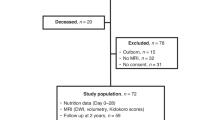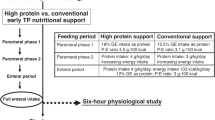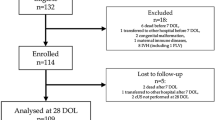Abstract
Background
Although early nutrition is associated with neurodevelopmental outcome at 2 years’ corrected age in children born very preterm, it is not clear if these associations are different in girls and boys.
Methods
Retrospective cohort study of infants born <30 weeks’ gestational age or <1500 g birth weight in Auckland, NZ. Macronutrient, energy and fluid volumes per kg per day were calculated from daily nutritional intakes and averaged over days 1–7 (week 1) and 1–28 (month 1). Primary outcome was survival without neurodevelopmental impairment at 2 years corrected age.
Results
More girls (215/478) survived without neurodevelopmental impairment at 2 years (82% vs. 72%, P = 0.02). Overall, survival without neurodevelopmental impairment was positively associated with more energy, fat, and enteral feeds in week 1, and more energy and enteral feeds in month 1 (P = 0.005–0.03), but all with sex interactions (P = 0.008–0.02). In girls but not boys, survival without neurodevelopmental impairment was positively associated with week 1 total intakes of fat (OR(95% CI) for highest vs. lowest intake quartile 62.6(6.6–1618.1), P < 0.001), energy (22.9(2.6–542.0), P = 0.03) and enteral feeds (1.9 × 109(9.5–not estimable), P < 0.001).
Conclusions
Higher early fat and enteral feed intakes are associated with improved outcome in girls, but not boys. Future research should determine sex-specific neonatal nutritional requirements.
Similar content being viewed by others
Log in or create a free account to read this content
Gain free access to this article, as well as selected content from this journal and more on nature.com
or
Change history
26 May 2021
A Correction to this paper has been published: https://doi.org/10.1038/s41390-021-01582-8
References
Martin, C. R. et al. Nutritional practices and growth velocity in the first month of life in extremely premature infants. Pediatrics 124, 649–657 (2009).
Koletzko, B. et al. 1. Guidelines on paediatric parenteral nutrition of the European Society of Paediatric Gastroenterology, Hepatology and Nutrition (ESPGHAN) and the European Society for Clinical Nutrition and Metabolism (ESPEN), supported by the European Society of Paediatric Research (ESPR). J. Pediatr. Gastroenterol. Nutr. 41(Suppl. 2), S1–S87 (2005).
Ehrenkranz, R. A. et al. Growth in the neonatal intensive care unit influences neurodevelopmental and growth outcomes of extremely low birth weight infants. Pediatrics 117, 1253–1261 (2006).
Embleton, N., Pang, N. & Cooke, R. J. Postnatal malnutrition and growth retardation: an inevitable consequence of current recommendations in preterm infants? Pediatrics 107, 270–273 (2001).
Kent, A. L., Wright, I. M. & Abdel-Latif, M. E. New South Wales, Australian Capital Territory Neonatal Intensive Care Units Audit Group Mortality and adverse neurologic outcomes are greater in preterm male infants. Pediatric 129, 124–131 (2012).
Cuestas, E., Bas, J. & Pautasso, J. Sex differences in intraventricular hemorrhage rates among very low birth weight newborns. Gend. Med. 6, 376–382 (2009).
Stevenson, D. K. et al. Sex differences in outcomes of very low birthweight infants: the newborn male disadvantage. Arch. Dis. Child Fetal Neonatal Ed. 83, F182–F185 (2000).
Hintz, S. R. et al. Gender differences in neurodevelopmental outcomes among extremely preterm, extremely-low-birthweight infants. Acta Paediatr. 95, 1239–1248 (2006).
Stålnacke, J. et al. A longitudinal model of executive function development from birth through adolescence in children born very or extremely preterm. Child Neuropsychol. 25, 318–335 (2019).
Barker, D. J. The fetal origins of type 2 diabetes mellitus. Ann. Intern. Med. 130(4 Pt 1), 322–324 (1999).
Lucas, A., Morley, R. & Cole, T. J. Randomised trial of early diet in preterm babies and later intelligence quotient. BMJ 317, 1481–1487 (1998).
Berry, M. J. et al. Neonatal milk supplementation in lambs has persistent effects on growth and metabolic function that differ by sex and gestational age. Br. J. Nutr. 116, 1912–25. (2016).
Cormack, B. E. et al. Does more protein in the first week of life change outcomes for very low birthweight babies? J. Paediatr. Child Health 47, 898–903 (2011).
Cormack, B. E. et al. Comparing apples with apples: it is time for standardized reporting of neonatal nutrition and growth studies. Pediatr. Res. 79, 810–820 (2016).
Ministry of Health. Ethnicity Data Protocols for the Health and Disability Sector (Ministry of Health, Wellington, NZ, 2004).
Parry, G., Tucker, J. & Tarnow-Mordi, W. CRIB II: an update of the clinical risk index for babies score. Lancet 361, 1789–1791 (2003).
Fenton, T. R. & Kim, J. H. A systematic review and meta-analysis to revise the Fenton growth chart for preterm infants. BMC Pediatr. 13, 1–13 (2013).
Patel, A. L. et al. Calculating postnatal growth velocity in very low birth weight (VLBW) premature infants. J. Perinatol. 29, 618–622 (2009).
Papile, L.-A. et al. Incidence and evolution of subependymal and intraventricular hemorrhage: a study of infants with birth weights less than 1,500 gm. J. Pediatr. 92, 529–534 (1978).
An international classification of retinopathy of prematurity. Prepared by an international committee. Br. J. Ophthalmol. 68, 690−697 (1984).
Chow, S. S. W. Report of the Australian and New Zealand Neonatal Network 2011 (ANZNN, Sydney, Australia, 2013).
Bell, M. J. et al. Neonatal necrotizing enterocolitis. Therapeutic decisions based upon clinical staging. Ann. Surg. 187, 1–7 (1978).
National Women's Health. National Women's annual clinical report 2018 (National Women's Health, Auckland, NZ, 2018). https://nationalwomenshealth.adhb.govt.nz/healthprofessionals/annual-clinical-report/national-womens-annual-clinical-report/.
Capra, S. and members of the working party. Nutrient Reference Values for Australia and New Zealand: Including Recommended Dietary Intakes (National Health and Medical Research Council (NHMRC), Canberra, Australia, 2006).
Agostoni, C. et al. Enteral nutrient supply for preterm infants: Commentary from the European Society of Paediatric Gastroenterology, Hepatology and Nutrition Committee on Nutrition. J. Pediatr. Gastroenterol. Nutr. 50, 85–91 (2010).
Hinde, K. First-time macaque mothers bias milk composition in favor of sons. Curr. Biol. 17, R958–R959 (2007).
Thakkar, S. K. et al. Dynamics of human milk nutrient composition of women from Singapore with a special focus on lipids. Am. J. Hum. Biol. 25, 770–79. (2013).
Powe, C. E., Knott, C. D. & Conklin-Brittain, N. Infant sex predicts breast milk energy content. Am. J. Hum. Biol. 22, 50–54 (2010).
Fumeaux, C. J. F. et al. Longitudinal analysis of macronutrient composition in preterm and term human milk: a prospective cohort study. Nutrients 11. https://doi.org/10.3390/nu11071525 (2019).
Fewtrell, M. S. et al. Randomized, double-blind trial of long-chain polyunsaturated fatty acid supplementation with fish oil and borage oil in preterm infants. J. Pediatr. 144, 471–479 (2004).
Lucas, A., Morley, R. & Cole, T. J. Randomised trial of early diet in preterm babies and later intelligence quotient. BMJ 317, 1481–1487 (1998).
Fields, D. A., Krishnan, S. & Wisniewski, A. B. Sex differences in body composition early in life. Gend. Med. 6, 369–375 (2009).
Dathan-Stumpf, A. et al. Pediatric reference data of serum lipids and prevalence of dyslipidemia: results from a population-based cohort in Germany. Clin. Biochem. 49, 740–749 (2016).
Narendran, V. et al. Interaction between pulmonary surfactant and vernix: a potential mechanism for induction of amniotic fluid turbidity. Pediatr. Res. 48, 120–124 (2000).
Nishijima, K. et al. Interactions among pulmonary surfactant, vernix caseosa, and intestinal enterocytes: intra-amniotic administration of fluorescently liposomes to pregnant rabbits. Am. J. Physiol. Lung Cell Mol. Physiol. 303, L208–L214 (2012).
Mikova, R. et al. Newborn boys and girls differ in the lipid composition of vernix caseosa. PLoS ONE 9, e99173 (2014).
Collins, C. T. et al. Neurodevelopmental outcomes at 7 years' corrected age in preterm infants who were fed high-dose docosahexaenoic acid to term equivalent: a follow-up of a randomised controlled trial. BMJ Open 5, e007314 (2015).
Lauritzen, L. et al. Maternal fish oil supplementation during lactation is associated with reduced height at 13 years of age and higher blood pressure in boys only. Br. J. Nutr. 116, 2082–90. (2016).
Christmann, V. et al. The early postnatal nutritional intake of preterm infants affected neurodevelopmental outcomes differently in boys and girls at 24 months. Acta Paediatr. 106, 242–249 (2017).
van den Akker, C. H. et al. Observational outcome results following a randomized controlled trial of early amino acid administration in preterm infants. J. Pediatr. Gastroenterol. Nutr. 59, 714–719 (2014).
Kiger, J. R. et al. Preterm infant body composition cannot be accurately determined by weight and length. J. Neonatal Perinat. Med 9, 285–290 (2016).
Acknowledgements
This study was supported by a Health Research Council of New Zealand Programme grant (12-095). A.C.T. was supported by a University of Auckland Senior Health Research Scholarship and a Gravida: National Centre for Growth and Development doctoral scholarship (12-01).
Author information
Authors and Affiliations
Contributions
Conception and design: J.E.H., F.H.B., A.C.T., J.M.A. Acquisition of data: J.M.A., A.C.T., J.T. Analysis and interpretation: J.E.H., A.C.T., B.E.C. Drafting the article: A.C.T., J.E.H., J.M.A. All authors critically revised and approved the manuscript.
Corresponding author
Ethics declarations
Competing interests
The authors declare no competing interests.
Additional information
Publisher’s note Springer Nature remains neutral with regard to jurisdictional claims in published maps and institutional affiliations.
Supplementary information
Rights and permissions
About this article
Cite this article
Tottman, A.C., Bloomfield, F.H., Cormack, B.E. et al. Sex-specific relationships between early nutrition and neurodevelopment in preterm infants. Pediatr Res 87, 872–878 (2020). https://doi.org/10.1038/s41390-019-0695-y
Received:
Revised:
Accepted:
Published:
Issue date:
DOI: https://doi.org/10.1038/s41390-019-0695-y
This article is cited by
-
Neonatal microbiome in the multiomics era: development and its impact on long-term health
Pediatric Research (2025)
-
Identification and prediction model of placenta-brain axis genes associated with neurodevelopmental delay in moderate and late preterm children
BMC Medicine (2023)
-
Sex differences in preterm nutrition and growth: the evidence from human milk associated studies
Journal of Perinatology (2022)
-
Early visuospatial attention and processing and related neurodevelopmental outcome at 2 years in children born very preterm
Pediatric Research (2021)
-
Do preterm girls need different nutrition to preterm boys? Sex-specific nutrition for the preterm infant
Pediatric Research (2021)



